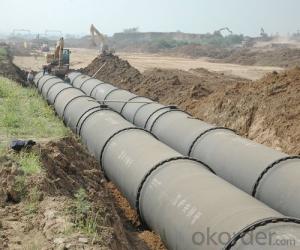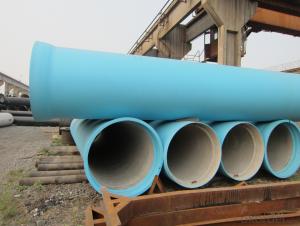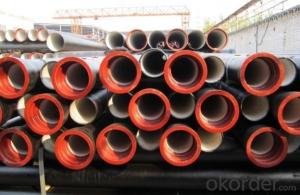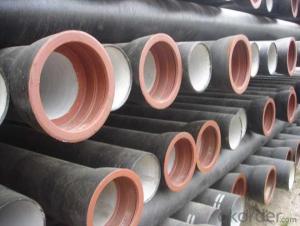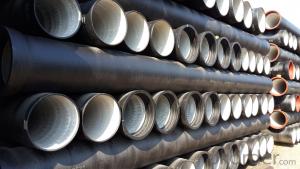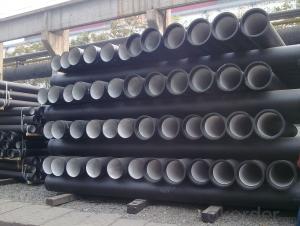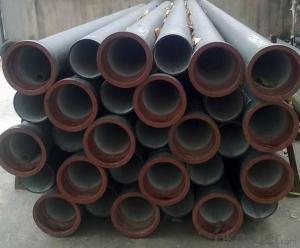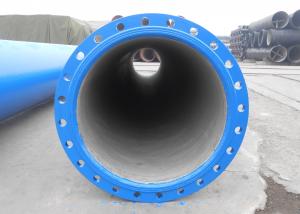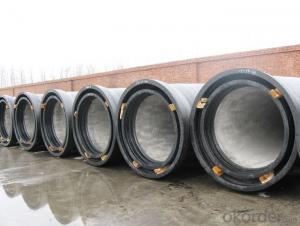Ductile Iron Pipe of China DN250-DN500 EN545 High Quality Chip Price
- Loading Port:
- China main port
- Payment Terms:
- TT or LC
- Min Order Qty:
- 20 m.t.
- Supply Capability:
- 100000 m.t./month
OKorder Service Pledge
OKorder Financial Service
You Might Also Like
1,Ductile Iron Pipe Description :
1) Pipes confirm to ISO2531,K9 class,T type joint,6m long,with inside cements lining conform to ISO4179, outside Zinc spraying(130g/m2) and bitumen coating(70μm) conform to ISO8179.
2) Pipe ends: Spigot and socket ends, with 100% SBR rubber gaskets accoding to ISO4633
3) we can do third party inspection according to customer's request.
4) Our products have been sold to many international market,such as Middle East and South East Asia and Africa.
2,Main Features of the Ductile Iron Pipe:
·High yield strength
·High tensile Strength
·High corrosion resistance
·Pressure Resistence
·Anti-corrosion
·Installation is convenient
·Satisfy the highest hygienic standards
Place of Origin: China (Mainland)
Model Number: DN80-1600 Length: 6M/5.7M/NEGOTIATED Standard: ISO2531 / EN545
Application: Potable/Sewage Water
Diameter: DN80-1600
Shape: Round
Hardness: 230 Pipe
Wall Thickness: standerd
Pull Strength: 420
Yield (≥ MPa): 300
Material: Ductile Iron water ductile iron pipe: SO2531 / EN545 DI pipe
3,Ductile Iron Pipe Images:
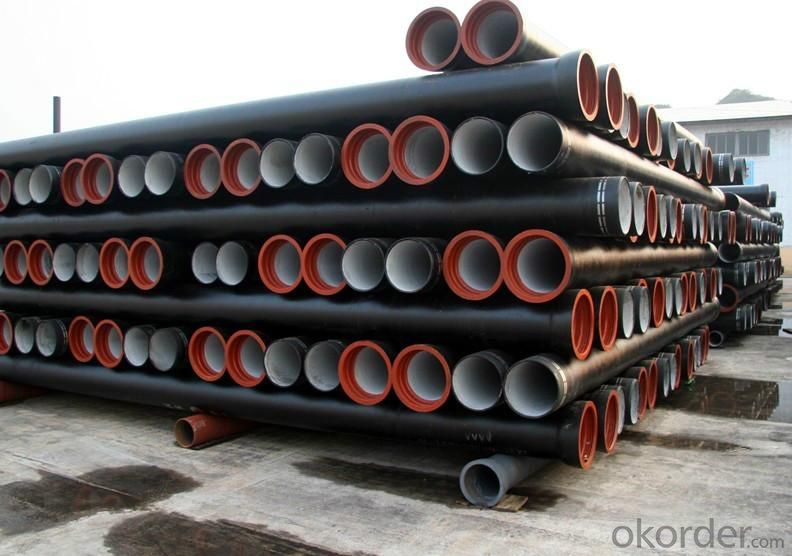
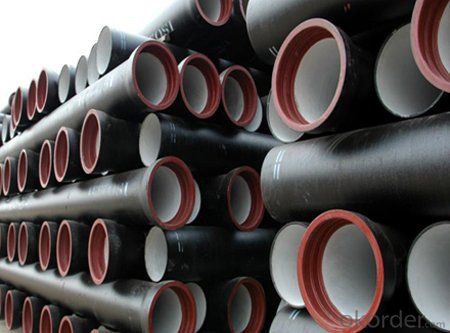
4. Ductile Iron Pipe Specification
Surface Finishes:Bare, Oiled, Mill Varnish, Galv,FBE, FBE Dual, 3LPE, 3LPP, Coal Tar,Concrete Coating and Tape Wrap
End Finishes: Beveled, Square Cut, Threaded, hat
Additional Services: Internal Coating
Packaging: packed in bag, plastic bag, steel strip, steel wire,double wire, iron box, wooden box,
tarpaulin, plastic sheeting
Inspection: MOODY SGS BV GL DNV ABS LIOYD’S
Test :X-ray, UT, magnetic particle,inspection,hydrostatic test.
Processing service :Beveling, Threading, Slotting, Cut-to length, Bends, Quench and Temper, Fabrication, Double-jointing and On-site assistance
5.FAQ:
We have organized several common questions for our clients,may help you sincerely:
1.Q: Why would you choose ductile iron pipe rather than other pipe materials?
A:The reasons are obvious for that not only ductile iron pipe possesses the inherent strength and flexibility of ductile iron, combined with proven corrosion protection systems, but also the cost savings can be achieved from design to installation and commissioning.
2.Q:Why can you guarantee the inner of pipes can’t be corroded?
A: High alumina cement mortar lining and sulphate-resistant cement mortar lining. These two special linings are applicable to inner anti-corrosion for sewage pipes, improving resistance to erosion of the sewage components.
- Q: Can ductile iron pipe be repaired if it gets damaged?
- Yes, ductile iron pipe can be repaired if it gets damaged. Various repair methods such as welding, clamping, and epoxy lining can be used to fix cracks, leaks, or other types of damage in ductile iron pipes. However, the repair method depends on the nature and extent of the damage, and it is recommended to consult with experts or professionals for proper repair procedures.
- Q: Can ductile iron pipes be used for bridge piers?
- Bridge piers can indeed utilize ductile iron pipes. These pipes possess remarkable strength and durability, rendering them suitable for various purposes, bridge construction included. Their resistance to corrosion is exceptional, and they withstand heavy loads with ease, making them a dependable choice for supporting bridge piers. Moreover, ductile iron pipes offer convenient installation and maintenance, which can be advantageous in bridge construction endeavors. Nonetheless, it is crucial to account for the specific requirements and design specifications of the bridge prior to selecting ductile iron pipes as the material for its piers. Thorough engineering evaluation and consideration of factors like load capacity, soil conditions, and environmental elements are indispensable for guaranteeing the suitability and safety of employing ductile iron pipes for bridge piers.
- Q: What quota can be used for the installation of DN300 ductile iron pipes?
- Ductile iron is a kind of high strength cast iron material developed in 50s twentieth Century, its comprehensive performance is close to the steel, it is based on its excellent performance, has been successfully used in casting complex stress, strength, toughness and wear resistance requirements of the higher parts. Nodular cast iron has developed rapidly to be second only to grey cast iron and widely used as cast iron material. The so-called "iron instead of steel", mainly refers to ductile iron.
- Q: Are ductile iron pipes suitable for use in irrigation pivot systems?
- Yes, ductile iron pipes are suitable for use in irrigation pivot systems. They are known for their durability, strength, and resistance to corrosion, making them a reliable choice for transporting water in agricultural applications. Additionally, ductile iron pipes have a high tolerance for pressure and can withstand the stresses caused by irrigation pivot systems.
- Q: How can the internal and external walls of ductile iron pipes be protected from corrosion?
- Inner wall cement anticorrosive exterior wall asphalt anticorrosion
- Q: Are ductile iron pipes suitable for trenchless pipe ramming installations?
- Yes, ductile iron pipes are suitable for trenchless pipe ramming installations. Ductile iron is a strong and durable material that can withstand the impact and stress of the ramming process. It has excellent tensile strength and can resist cracking or breaking under pressure. Additionally, ductile iron pipes are resistant to corrosion, making them a suitable choice for underground installations. The smooth interior surface of ductile iron pipes also facilitates the flow of fluids or gases. Overall, ductile iron pipes are a reliable and cost-effective option for trenchless pipe ramming installations.
- Q: What is the expected thrust restraint method for ductile iron pipes?
- Typically, to achieve the expected thrust restraint for ductile iron pipes, mechanical joint restraints are employed. These restraints are designed to counteract the axial forces or thrust caused by the fluid pressure within the pipe. Thrust blocks, tie rods, and harness restraints are the most commonly used types of mechanical joint restraints for ductile iron pipes. Thrust blocks are concrete structures strategically placed around the pipe joints to resist the thrust forces. They are typically constructed at bends, tees, and other directional changes to prevent pipe movement. Tie rods, on the other hand, are another frequently used method of thrust restraint. These involve steel rods that are anchored to the pipe and securely fastened to an immovable structure to counter the thrust forces. Harness restraints, however, are constituted by a series of steel rods or cables that encircle the pipe and are anchored to the ground on both sides. These restraints effectively distribute the axial forces along the pipe's length, preventing movement and ensuring stability. The choice of a specific thrust restraint method for ductile iron pipes may vary depending on various factors such as pipe diameter, fluid pressure, soil conditions, and local regulations. It is vital to consult industry standards, engineering guidelines, and local authorities to determine the appropriate thrust restraint method for a particular application.
- Q: How does ductile iron pipe perform in areas with high soil consolidation?
- Ductile iron pipe performs well in areas with high soil consolidation due to its inherent strength and durability. The pipe's flexibility allows it to withstand ground movement, settlement, and consolidation without compromising its structural integrity. Additionally, ductile iron is resistant to corrosion, making it a suitable choice for areas with varying soil conditions.
- Q: What are the different joint types available for ductile iron pipes?
- There are several different joint types available for ductile iron pipes. These joints play a crucial role in ensuring the integrity and reliability of the pipeline system. 1. Push-on Joint: This is the most common type of joint used for ductile iron pipes. It involves a rubber gasket that is placed inside the bell end of the pipe, and the spigot end is then pushed into the bell, creating a tight seal. This joint is quick and easy to assemble and provides excellent resistance to soil movement and water pressure. 2. Mechanical Joint: This joint involves a gland and follower that are tightened around the spigot end of the pipe using bolts and nuts. The mechanical joint provides a strong and durable connection and is commonly used for larger diameter pipes or in applications where higher pressure or thrust loads are expected. 3. Flanged Joint: Flanged joints are used when the pipes need to be connected to other components, such as valves or fittings. The ends of the pipes are machined and fitted with flanges that are bolted together using gaskets to create a secure connection. Flanged joints are often used in industrial applications or where frequent disassembly is required. 4. Restrained Joint: Restrained joints are designed to withstand higher thrust forces and prevent the pipe from separating or pulling apart. They typically utilize a combination of mechanical joint components, such as bolts and glands, along with additional restraining elements like welded or bolted-on restraints. These joints are commonly used in high-pressure applications or where the pipeline is subjected to significant external forces. It is important to select the appropriate joint type based on factors such as pipeline design, operating conditions, and installation requirements. Consulting with a knowledgeable engineer or pipe manufacturer can help determine the most suitable joint type for a specific ductile iron pipe application.
- Q: If the ductile iron pipe is broken, can we use rush repair?
- These specifications are also based on the outer diameter of the tube. In daily life, we may also encounter a pipeline rupture, or when it is on the road to repair, excavator accidentally hit PE, PPR water supply and drainage pipeline, as long as a little, can be used to repair the pipeline repair section.
Send your message to us
Ductile Iron Pipe of China DN250-DN500 EN545 High Quality Chip Price
- Loading Port:
- China main port
- Payment Terms:
- TT or LC
- Min Order Qty:
- 20 m.t.
- Supply Capability:
- 100000 m.t./month
OKorder Service Pledge
OKorder Financial Service
Similar products
Hot products
Hot Searches
Related keywords
